Table of contents
- Scene – A visit to the Hepako foundry Specialist for small series
- Specialist for small series
- Good castings require good models
- Prices for cast reproductions are usually manageable

Siemer
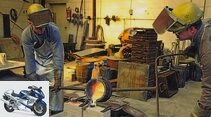

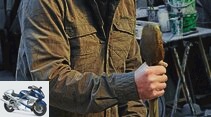
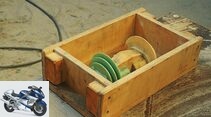
14th pictures
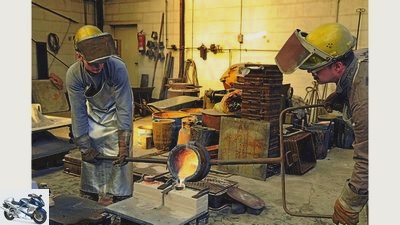
Siemer
1/14
If running boards or engine covers crumble, cylinders lose all their ribs on the outside and can no longer hold the cylinder liner inside, only one thing helps: going to a knowledgeable foundry.
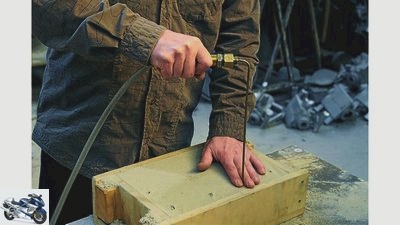
Siemer
2/14
So that the molding material hardens faster, the former introduces compressed air with a long lance at very close intervals.
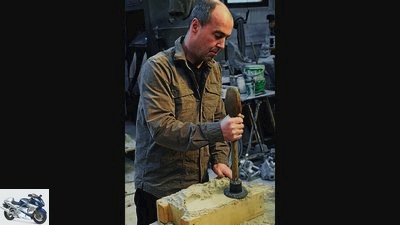
Siemer
3/14
Then tamp down thoroughly. Excess material is drawn off.
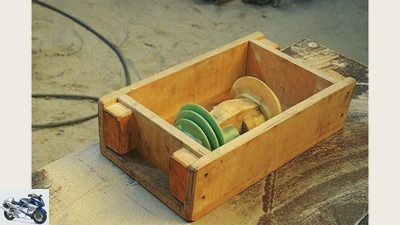
Siemer
4/14
The model for two half rocker arm housing covers is in its box. The counterparts are created in the other box. The box is carefully filled with sand.
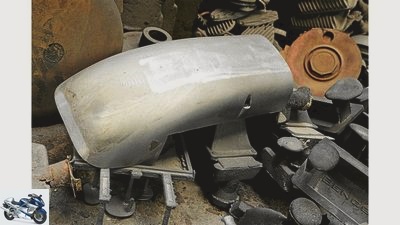
Siemer
5/14
The BMW engine cover is made of cast aluminum, but of course you can also master brass, gray and iron castings at Hepako.
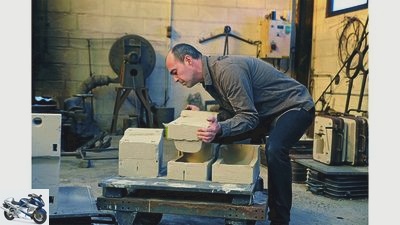
Siemer
6/14
Jens Hansemann puts the two halves of the form on top of each other with the greatest care. Before casting, they are weighted down with heavy iron parts and are also given a pouring funnel.
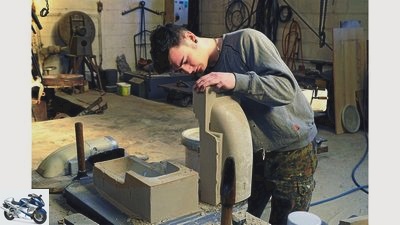
Siemer
7/14
The two halves of the mold were created in two boxes. Here they are being critically examined, the plastic model can be seen at the end of the work table.
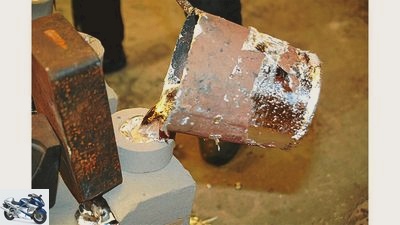
Siemer
8/14
1000 degree hot brass melt flows into the mold – a veteran’s throttle is created.

Siemer
9/14
The much sought-after Guzzi Lima lids only need to be cleaned, the client takes care of the polishing.
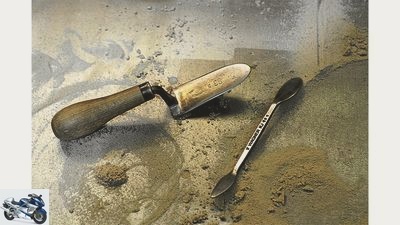
Siemer
10/14
The former does fine work with a lancet and polishing spoon.
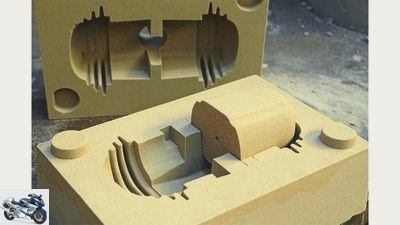
Siemer
11/14
Again, with the greatest care, the core is brought into position. You can clearly see the fits on the two halves, which they then allow to lie exactly on top of each other. The pouring channel through which the metal will eventually flow into the mold is also clearly visible in the standing rear half.
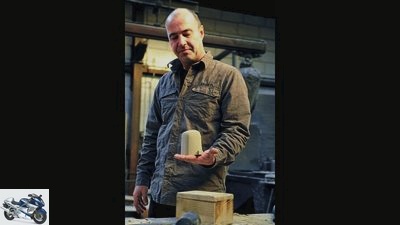
Siemer
12/14
A core must be placed in the mold where the casting is to remain hollow. Of course, it also needs a model and comes in its own form.
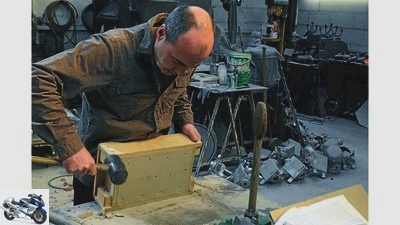
Siemer
13/14
After a surprisingly short time, the form can be carefully removed from its box. But it remains very sensitive, especially in its fine structures.
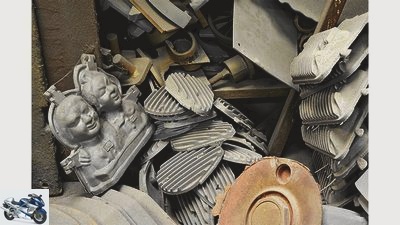
Siemer
14/14
At the bottom right there are clearly Kawa covers, and no, at the bottom left, these are not Harley parts.
counselor
traffic & business
Scene – A visit to the Hepako foundry
Scene – A visit to the Hepako foundry
Specialist for small series
Content of
If running boards or engine covers crumble, cylinders lose all their ribs on the outside and can no longer hold the cylinder liner inside, only one thing helps: going to a knowledgeable foundry.
Fred Siemer
08/06/2015
Long ago people began to pour heated and, in this way, liquefied metal into molds. We remember. Bronze Age and such, seventh grade history class. It was a long time ago, but Homo sapiens has been handling iron for around 3000 years. In any case, very few trades can look back on a longer tradition than that practiced by Jens Hansemann: He is a master former and owner of the small Hepako foundry from Syke near Bremen. The job title already indicates where the priorities are when pouring, but before the boss can explain this in more detail, his phone rings and gives some time to get used to.
Buy complete article
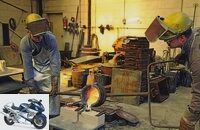
Scene – A visit to the Hepako foundry
Specialist for small series
6 pages) as PDF
€ 2.00
Buy now
A foundry like this is above all warm. Fan ovens roaring at the rear left constantly heat up the melt, keeping it in constant readiness. Besides, it’s damn dusty here. At the back right, the mouth of an outside silo opens into the inside of the hall, from which Marvin, the apprentice, lets fine-grain sand flow into a mobile vat. A little later, the vat ends up in a mixer, where the quartz sand is mixed with chemical binders. Marvin shovels the finished mixture into lockable barrels – so that it stays fresh longer. He balances one thing at his workplace, and the content is no longer called sand, but molding material. But it remains dusty. On the other hand, the profession that Marvin is learning has been called a foundry mechanic for almost 20 years now. Which has not changed anything in the work that is now pending.
Specialist for small series
A model is lying on the wooden table, it seems somehow familiar. From which Jens Hansemann, who has just reappeared, concludes that his visitor must be familiar with BMW. A little, that’s right, and now the penny is falling: This is the upper beveled engine cover that everyone screws onto their old two-valve engine when they have rationalized the air filter. The order comes from a well-known supplier of accessories, there is great interest, the apprentice rolls his eyes – for days he has not been producing anything other than the two halves of this sand mold. Almost a major order for Hepako, where people live from small series and one-offs, from modern sculptures to typeface plates to classicist ornaments. Not infrequently, then, of reproductions, and this keyword includes a lot of what the veteran motorcycle fool Hansemann pours for young and old timers.
Everything that is available as a cast part can also be cast again. With this extremely reassuring credo, the 46-year-old accepts orders from the scene. Mostly they come from dealers or restorers, occasionally from clubs, but one-offs are also not uncommon. If no technical drawing or model exists, the mold will be taken from the original. However, this can cause some effort when metallic surfaces have been gnawed by the ravages of time. For a day and a half, Hansemann smoothed the cooling fins of a scarred and battered cylinder with plasticine before he could mold it to build so-called false halves. These are used to find parting lines for the molding box. Only then is the final mold created.
Good castings require good models
Cast parts that are not taken from the original require a model. This is what the model maker does, and every foundry has an almost neurotic relationship to this: good castings require good models. They were made from wood in the past, now mostly from plastic and are often true works of art. Not just a template for the cast part, but also optimized with regard to further processing and the casting process. The metal must flow in quickly and the gases produced must be able to escape unhindered. In addition, the model maker naturally takes into account that metal reduces its volume when it cools. To compensate for this so-called shrinkage, the model must be slightly larger than the desired end result, in the case of aluminum alloys around 1 to 1.5 percent. This is important if the screw holes in the BMW bonnet are to be aligned with the holes in the housing.
A model can take between 100 and 200 casts, and Marvin takes a critical look at all the neuralgic points as he lifts the one he used from the bed of sand. Okay, go. Now touch up a little with the polishing spoon (looks like a miniature mason’s trowel) and fine-tuning with the lancet (could also be used as a dentist’s instrument) to smooth the bars or remove excess material from the edges, then the first half of the mold is finished. Meanwhile, Jens Hansemann is working with a coarser, but better-known device: with a screeching motion, his Flex frees a double cylinder from the sprue. This is the name of the solidified metal in the casting channel of the casting mold, and of course that has to go before the cylinder goes to the Dutch client. An English specialist who now prefers to have it poured in Syke than in England.
Prices for cast reproductions are usually manageable
Jens Hansemann often has new cylinders for vintage cars on his workbench. For cleaning, this is the name given to cleaning the cast parts from molding material, metal oxide and sprues. BSA, Matchless-V2, JAP – everything has already been there. He once made the sack cylinder of an ancient NSU for the German Two-Wheeler and NSU Museum in Neckarsulm. And he remembers flathead cylinders particularly vividly because he had to position five cores there before casting. Cores are precisely shaped sand elements that are inserted wherever it should remain hollow afterwards. Because bumpers are at work there, pistons are supposed to race up and down. It’s hot, it’s dusty, the sand is heavy, and especially the crucible with the melt. And yet Hansemann and his pen still do precise work here. All day long
With the right number of items, a cylinder is not even particularly expensive. Of course, there are also the costs for the liner and finishing. Nevertheless, the prices for cast reproductions remain manageable, and word of that seems to get around: Here is the primary box cover for a Wanderer, there the ignition cover for a Matchless. Wonderful running boards for Viktorias rest under a table, on top the brass innards of a throttle for something very old. Not far from the sandblasting cabin, the characteristic corrugated covers of Kawasaki Z-engines are waiting to be cleaned, in front of them a whole heap of Guzzi generator covers. Typical orders from the youngtimer scene: The Kawa parts are no longer available, they are sought worldwide; The Guzzi lids are a big hit because the manufacturer used black plastic instead of metal for a few years and are now converting them all.
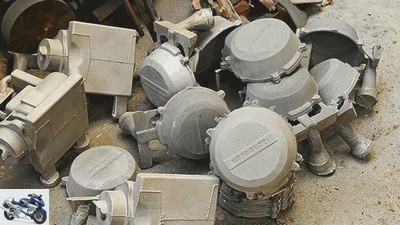
Siemer
The much sought-after Guzzi Lima lids only need to be cleaned, the client takes care of the polishing.
With a heavy tamper, Marvin solidifies the sand mixture in the second half of the mold. Excess is drawn off, then he blows compressed air into the mixture with a thin lance. Every few centimeters, and as if by magic, the molding material is hard in no time. Amazing, really. The wooden form can be carefully removed, the usual rework, done. Of course, this structure must never fall over or even fall over, but you can grab one half and carry it through the hall, apprentice and master show how it is done. Then Jens Hansemann puts the halves of the eight molds together, and his expression already reveals that no disruptions are desired. If it jerks or wobbles while doing so, a lot of the work was completely in vain because edges could break off. Done. Then heavy iron parts are placed on the molds, and then it’s time to go.
They want to water tomorrow morning. The oven stays on. So that it just doesn’t cool down. In the crucible, in the hall. After hardening, you will expose the covers with gentle blows of the hammer. After that, all that remains of the sand molds is a fairly large pile of dust. In sand casting, you always work with lost forms. The apprentice has long since grudgingly grasped this. Large industrial series, on the other hand, are created in permanent forms, the molds. He knows that from vocational school.
Related articles
-
Siemer 13th pictures Fred Siemer 1/13 Order situation: From the boxer conversion to the XT 500 to the Tornax, everything is stocked. Fred Siemer 2/13 Tin…
-
Fred Siemer Sports & scene Scene: Moto Guzzi Baker Scene: Moto Guzzi Baker The workshop of the Guzzi specialist Content of Anyone who trades with Moto…
-
Schulz motorcycles Scene: Harley and MZ meeting Scene: Harley and MZ meeting Harley-Fete and MZ-Emmenrausch Some celebrate their 105th birthday, others…
-
Horex 23 pictures Horex 1/23 Horex 6-cylinder motorcycle: working on the model of the cylinder head. Horex 2/23 Horex 6-cylinder motorcycle: the red…
-
Foitzik to travel Scene: Burt Munro Challenge Scene: Burt Munro Challenge Isle of Man, just the other way around At the southernmost end of New Zealand,…
-
Scene: Portrait of Ferry Brouwer
Siemer Sports & scene Scene: Portrait of Ferry Brouwer Scene: Portrait of Ferry Brouwer To ask! Content of He was a mechanic for greats like Phil Read…
-
MOTORRAD home visit Dr. Wack: In the S100 test laboratory
Tobias Beyl 17th pictures Tobias Beyl 1/17 The MOTORRAD home visit is entering the first round. Tobias Beyl 2/17 The wear of the test body – wetted with…
-
Scene: This is how mail-order motorcycle sales work
Bilski accesories Scene: This is how mail-order motorcycle sales work Scene: This is how mail-order motorcycle sales work Mail from Doreen… In addition…
-
Factory visit to HJC in Vietnam
Breakable 20th pictures Breakable 1/20 MOTORRAD visited one of the largest helmet manufacturers in the world. HJC stands for affordable, but high-quality…
-
Scene: Portrait of two-stroke fan Scherubl
Siemer 15th pictures Siemer 1/15 The two-stroke fan Gunter Scheruebl transforms old series motorcycles into racing replicas. Siemer 2/15 Scherubl can…